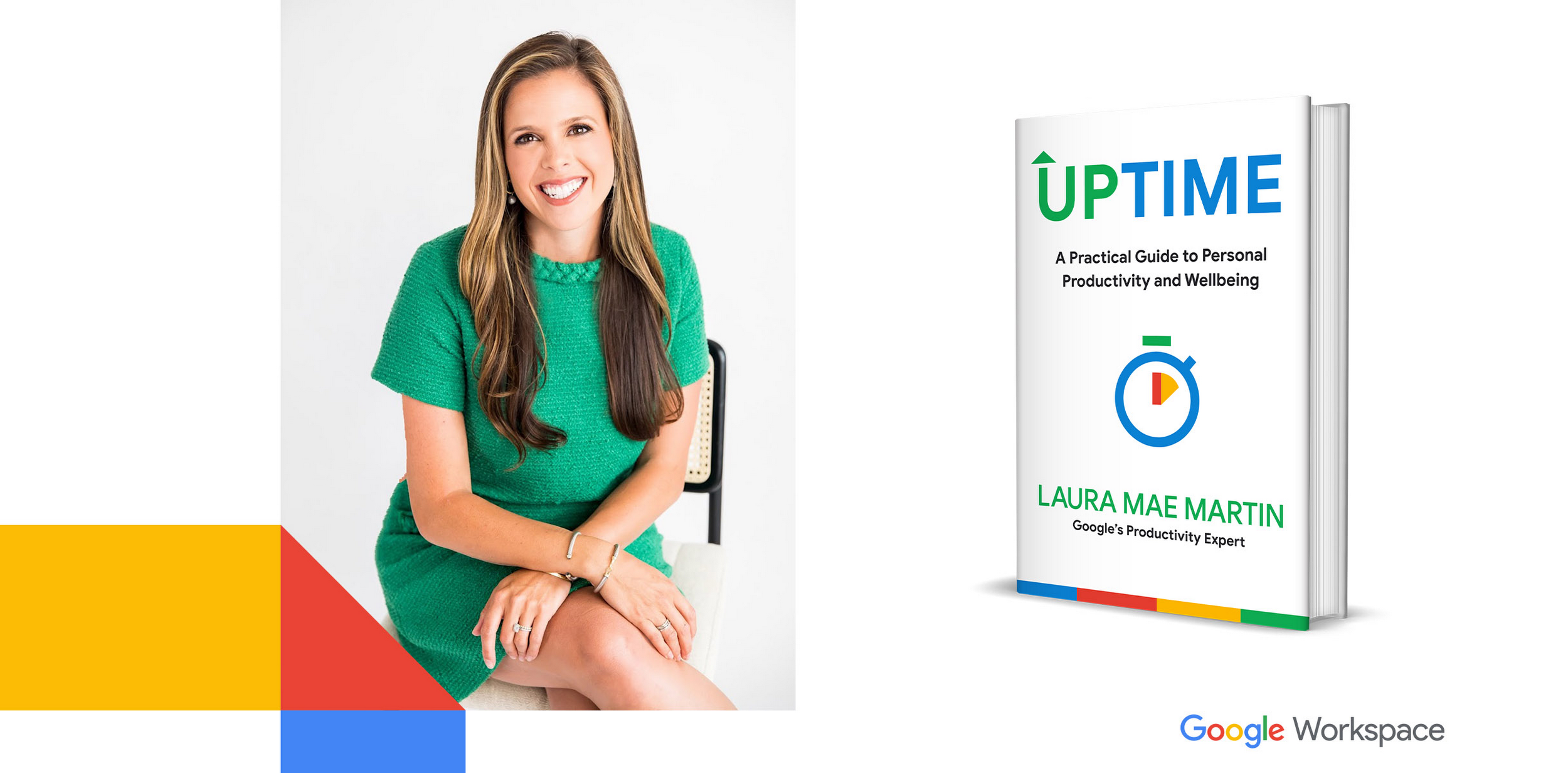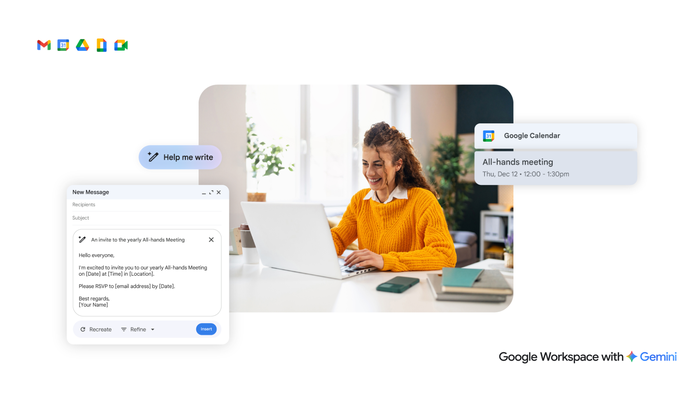Google’s productivity guru shares 7 tips from her new book

The Google Workspace Team
Google Workspace Newsletter
Keep up with the evolving future of work and collaboration with insights, trends, and product news.
SIGN UPLaura Mae Martin has coached thousands of executives and employees at Google and externally on the principles of time management, email management, and wellbeing, with a focus on personal productivity. Now she’s published a book — “Uptime: A Practical Guide to Personal Productivity and Wellbeing” — that shares her sage advice with the rest of the world.
Laura Mae Martin began her journey at Google nearly 14 years ago as an account manager in the sales organization. Shortly after joining, she realized her success with clients was intrinsically linked to her ability to effectively manage her time. Laura eventually transitioned out of sales and built the Productivity@Google program. As Google’s Executive Productivity Advisor, she has taught her methods for owning and managing time at work, school, and home to employees at every level — from new hires to global executives. She’s also trained employees and leaders from some of Google Workspace’s largest global customers.
Everything Laura knows about productivity can be found in “Uptime,” which came out today with HarperCollins. In the book, she explains that productivity is “1) defining clearly what you want to do, 2) setting aside the (right) time and place to do it, and 3) executing well within designated periods.” Laura calls this consistent practice finding your "Uptime" — the sweet spot when you're operational, productive, and well, no matter what you’re choosing to do. Whether you’re an employee, student, parent, executive, or entrepreneur, here are seven tips from Laura’s book that will help you find your Uptime.
1. Learn how to say no and set boundaries
There’s a delicate balance between protecting your time and maintaining relationships with others. In her book, Laura makes it clear that every “yes” means saying “no” to something else, whether it’s downtime, a hobby, or another work commitment. Laura recommends taking a “launch and iterate” approach. Rather than viewing a “no” as a permanent decision, think of it as a temporary choice. You can experiment with saying no to a project or commitment for a specific period of time, like a week or a month. This will allow you to see the impact the time has on your energy and schedule. For instance, for one quarter, you can schedule your team meeting for every two weeks instead of weekly, and see what that does for your team’s decision-making speed and connection.
Laura also explains that the best way to say no — especially to incoming requests — is to communicate your boundaries upfront and from a positive standpoint. For example: “I take meetings Monday through Thursday” is a positive way of saying “I don’t take meetings on Friday.”
2. Find your Power Hours, then protect them
The two to three hours a day that you feel your most productive are what Laura calls your “Power Hours.” Laura suggests taking two weeks to discover your Power Hours. Keep a notepad close, and whenever you're feeling focused, take note of the times and conditions around you. Maybe you’re getting more done during the morning silence. Or maybe you excel at midnight with your headphones on. Once you’ve identified your Power Hours, try to block out those time periods on your calendar for tackling top priorities. During your Off-Peak Hours when you’re feeling less productive, turn to meetings, brainstorms, emails, articles, and routine tasks.
3. Prioritize downtime (it's the key to Uptime)
Laura argues that intentionally choosing to relax your brain and do something totally unrelated to work — napping, walking the dog, having a tech-free lunch — is productive. In her book, she notes that you must prioritize downtime to achieve Uptime. She explains that when she asks people where they come up with their best ideas, they often mention being in the shower, on their commute, or in the kitchen making dinner — never while sitting in back-to-back meetings or wading through countless emails. Laura suggests structuring small pockets of intentional downtime throughout your schedule. This can be one or two days of vacation periodically or a 20-minute break each day. Doing this will let your brain absorb all that information you take in. Laura also recommends adding at least one hour of silent awake time to your day. And that hour doesn’t have to be consecutive; even just 15 minutes here or there is helpful to unlocking creativity.
4. Use tricks to beat procrastination
Kicking procrastination can be tough, but there are a few methods Laura offers to stay on task. One is to act like your own assistant. When putting off a project, ask yourself, “If I was someone’s assistant, and I wanted my boss to get this done tomorrow, what would I do to nudge them along gently and make it easier?” Laura explains that being your own assistant will help you set up circumstances that clear the path to getting things done. Say you want to make muffins in the morning. If you’re acting as your own assistant and setting your boss (future you) up for success, you can place the muffin tin and ingredients on the counter the night before. Similarly, a big part of acting as your own assistant also means thinking of all the things that might distract you during a work block — before you start, be sure you have snacks and water on hand, close and minimize tabs, and use the restroom.
5. Designate hot spots and not spots
Identifying locations where you’re most likely to get things done helps you develop routines and spots for certain tasks. Whether your work is in an office, at home, or a hybrid of the two, associating certain locations with particular work trains your brain to easily slip into activities. If you’re a hybrid worker and you focus better at home, use at-home days to prioritize big projects that need heads-down attention, and leave lighter-weight tasks or quick email replies for your next in-office day — and vice versa.
It’s important to understand the associations you hold — and can create — for specific areas. “Hot spots” are places you associate with specific work-related tasks. For example, you might have a routine of answering client emails at your office desk, or you always do expenses in the big comfy chair in your living room, or you only brainstorm for new projects in the neighborhood café on Thursdays. Laura also believes it’s just as important to identify your “not spots,” designated places where you do not work. You should exclusively use these areas for non-work activities, and they will help preserve your emotional wellbeing and encourage vital relaxation.
6. Do your email like you do your laundry
Studies show that people at work check email about eleven times per hour. Laura recommends a three-step process for cleaning up your inbox. The first step is to remove what you don’t need to see, such as any newsletters or alerts you’ve accidentally signed up for. You can do this by creating filters or rules in Gmail to ensure that emails you don’t read never even hit your inbox. Gamifying this task can make it less tedious — set a timer for 30 minutes and see how many unnecessary emails you can eliminate in that timeframe.
On the other hand, Laura suggests making emails you do need to see stand out. You can give yourself information about what’s inside an email before you even open it. In Gmail, this means adding a label automatically to emails using a filter rule. For example, if an email is from your manager, sent directly to you, give it a label.
The last step is to sort emails like you’d sort your laundry. Laura explains that creating three separate “baskets” for your email — respond, read, revisit — helps empty your dryer (your inbox). Schedule designated times for sorting, reading, and answering emails. And remember, these are distinct activities that shouldn’t be mixed.
7. Turn your tools into power tools
It’s easy to forget that the settings on tech products are designed to set you up for success. Laura recommends taking 20 minutes to see what your tools can do for you. For instance, once shortcuts are enabled in your Gmail settings, you can save time every day by pressing “r” on your keyboard to reply to an email.
Similarly, when looking at programs that you see multiple times a day — like email or your calendar — it can help to add small things that make them more visually appealing and engaging. This can be as simple as adding the plane emoji next to all of the flights listed on your calendar.
Laura recommends this same approach to exploring how generative AI tools like Gemini for Google Workspace can boost your productivity. Spend some time playing with different prompts to see how you get the best results and iterate from there.
These seven tips are just a sample of Laura’s productivity tips that you’ll find in “Uptime: A Practical Guide to Personal Productivity and Wellbeing.” You can purchase the book now at Laura’s website, with links to all the major booksellers.



